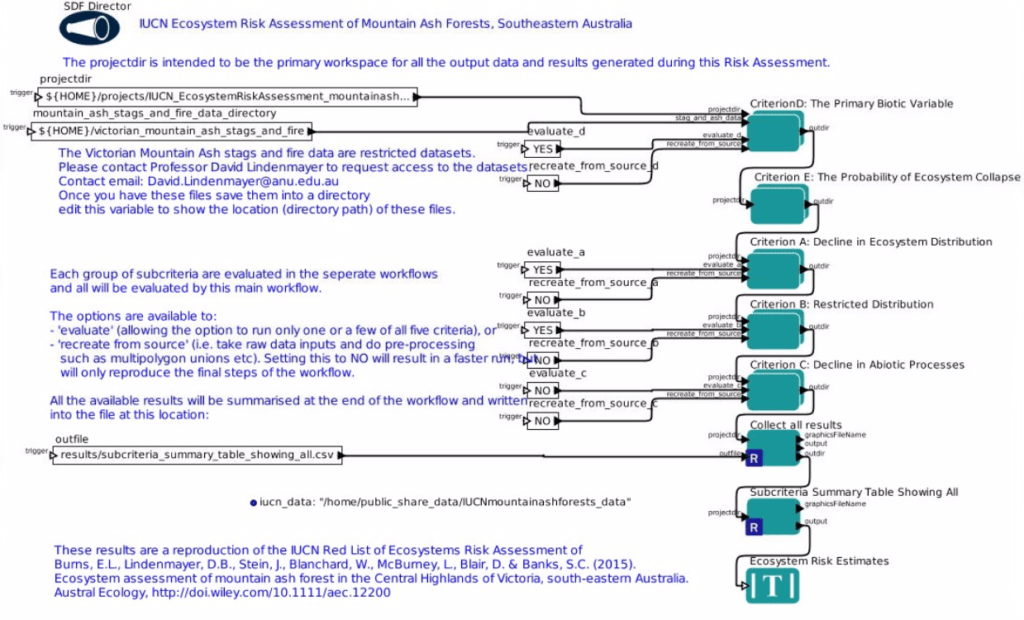CoESRA Case Study 1: Mountain Ash
IUCN Ecosystem Risk Assessment of Mountain Ash Forests
Project Description
The International Union for Conservation of Nature (IUCN) has developed a Red List of Ecosystems (RLE) framework to methodically assess the status of an ecosystem based on characteristic biota and ecological processes [1][2]. Under the IUCN RLE, the ecosystem is assessed for the risk of collapse based on criteria A–E as follows: “A) rates of decline in ecosystem distribution; B) restricted geographic distribution with continuing declines or threats; C) rates of environmental (abiotic) degradation; and D) rates of disruption to biotic processes”. The fifth criteria (E) quantifies the risk of ecosystem collapse. The four criteria (A–D) have three sub-criteria for assessment and outcomes of these criteria range from Least Concern (LC) to Critically Endangered (CR). The overall evaluation is determined according to the most severe ranking of the five criteria [3].
The Mountain Ash forest ecosystem assessment was performed by Burns et al. [4] . According to their assessment, there is a 92% to 99% chance that the ecosystem will collapse by 2067. A complete reproducible Kepler workflow has been developed to reproduce Mountain Ash forest IUCN RLE assessment. Users can access CoESRA virtual desktop to re-run the IUCN assessment and generate all the results that formed the assessment [5]

Reproducible IUCN RLE of Mountain Ash Forest in south eastern Australia
Collaborators
- Fenner School, Australian National University
- Australian National Data Services
How to run
Login to CoESRA virtual desktop and following below instructions:
- In the application menu, click on CoESRA and Kepler.
- On the left-hand side menu in Kepler, click on “Coesra-tern” and “IUCN_assessment_mountainash_forest” folder.
- Double click on workflow icons with the name “IUCN_EcosystemRiskAssessment_mountainashforests.xml”.
The workflow will open in a new window and click a play button in the menu icon to run the workflow.
References
- D. A. Keith, J. P. Rodríguez, K. M. Rodríguez-Clark, E. Nicholson, K. Aapala, A. Alonso, M. Asmussen, S. Bachman, A. Basset, E. G. Barrow, J. S. Benson, M. J. Bishop, R. Bonifacio, T. M. Brooks, M. A. Burgman, P. Comer, F. A. Comín, F. Essl, D. Faber-Langendoen, P. G. Fairweather, R. J. Holdaway, M. Jennings, R. T. Kingsford, R. E. Lester, R. M. Nally, M. A. McCarthy, J. Moat, M. A. Oliveira-Miranda, P. Pisanu, B. Poulin, T. J. Regan, U. Riecken, M. D. Spalding, and S. Zambrano-Martínez, “Scientific Foundations for an IUCN Red List of Ecosystems,” PLoS ONE, vol. 8, p. e62111, 2013.
- J. P. Rodriguez, K. M. Rodriguez-Clark, J. E. M. Baillie, N. Ash, J. Benson, T. Boucher, C. Brown, N. D. Burgess, B. E. N. Collen, M. Jennings, D. A. Keith, E. Nicholson, C. Revenga, B. Reyers, M. Rouget, T. Smith, M. Spalding, A. Taber, M. Walpole, I. Zager, and T. Zamin, “Establishing IUCN Red List Criteria for Threatened Ecosystems Establecimiento de Criterios para la Lista Roja de UICN de Ecosistemas Amenazados,” Conservation Biology, vol. 25, pp. 21-29, 2011.
- J. P. Rodríguez, D. A. Keith, K. M. Rodríguez-Clark, N. J. Murray, E. Nicholson, T. J. Regan, R. M. Miller, E. G. Barrow, L. M. Bland, K. Boe, T. M. Brooks, M. A. Oliveira-Miranda, M. Spalding, and P. Wit, “A practical guide to the application of the IUCN Red List of Ecosystems criteria,” Philosophical Transactions of the Royal Society of London B: Biological Sciences, vol. 370, 2015-02-19 00:00:00 2015.
- E. L. Burns, D. B. Lindenmayer, J. Stein, W. Blanchard, L. Mcburney, D. Blair, and S. C. Banks, “Ecosystem assessment of mountain ash forest in the Central Highlands of Victoria, south-eastern Australia,” Austral Ecology, vol. 40, pp. 386-399, Jun 2015.
- S. Guru, I. C. Hanigan, H. A. Nguyen, E. Burns, J. Stein, W. Blanchard, D. Lindenmayer, and T. Clancy, “Development of a cloud-based platform for reproducible science: A case study of an IUCN Red List of Ecosystems Assessment,” Ecological Informatics, vol. 36, pp. 221-230, 11// 2016






